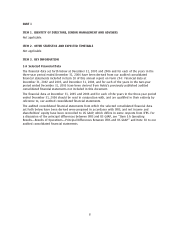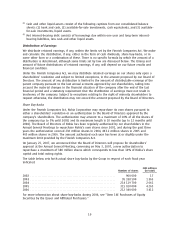Nokia 2006 Annual Report Download - page 19
Download and view the complete annual report
Please find page 19 of the 2006 Nokia annual report below. You can navigate through the pages in the report by either clicking on the pages listed below, or by using the keyword search tool below to find specific information within the annual report.compliance with all applicable laws. Siemens has agreed to indemnify Nokia and Nokia Siemens
Networks for any government fines or penalties and damages from civil law suits incurred by either,
as well as in certain instances for loss of business through terminated or renegotiated contracts,
based on violations of law in the Siemens carrierrelated operations that occurred prior to the
transfer to Nokia Siemens Networks.
We cannot predict with any certainty the final outcome of any investigations related to this matter,
when and the terms upon which the various investigations will be resolved, which could be a
number of years, or the consequences of the alleged or any possible future violations of law on the
business of Nokia Siemens Networks, including its relationships with customers.
Our products and solutions include increasingly complex technologies some of which have
been developed or licensed to us by certain third parties. As a consequence, evaluating the
rights related to the technologies we use or intend to use is more and more challenging, and
we expect increasingly to face claims that we have infringed third parties’ intellectual
property rights. The use of these technologies may also result in increased licensing costs for
us, restrictions on our ability to use certain technologies in our products and solution
offerings, and/or costly and timeconsuming litigation, which could have a material adverse
effect on our business and results of operations.
Our products and solutions include increasingly complex technologies some of which have been
developed or licensed to us by third parties. As the amount of such proprietary technologies and the
number of parties claiming intellectual property rights continues to increase, even within individual
products, and as the Nokia product range becomes more diversified and Nokia enters new
businesses, and as the complexity of the technology increases, the possibility of alleged infringement
and related intellectual property claims against us continues to rise. The holders of patents and
other intellectual property rights potentially relevant to our product and solution offerings may be
unknown to us, may have different business models, or may otherwise make it difficult for us to
acquire a license on commercially acceptable terms. There may also be technologies licensed to and
relied on by us that are subject to infringement or other corresponding allegations or claims by
others which could damage our ability to rely on such technologies. In addition, although we
endeavor to ensure that companies that work with us possess appropriate intellectual property
rights or licenses, we cannot fully avoid risks of intellectual property rights infringement created by
suppliers of components and various layers in our products and solutions or by companies with
which we work in cooperative research and development activities. Similarly, we and our customers
may face claims of infringement in connection with our customers’ use of our products and
solutions.
In many aspects, the business models for mobile services have not yet been established. The lack of
availability of licenses for copyrighted content, delayed negotiations, or restrictive copyright licensing
terms may have an adverse effect on the cost or timing of content related services by us, operators
or third party service providers, and may also indirectly affect the sales of our mobile devices.
Since all technology standards, including those used and relied on by us, include some intellectual
property rights, we cannot fully avoid risks of a claim for infringement of such rights due to our
reliance on such standards. We believe that the number of third parties declaring their intellectual
property to be relevant to these standards, for example, those standards related to socalled 3G
mobile communication technologies, including 3GPP and 3GPP2, as well as other advanced mobile
communications standards, is increasing, which may increase the likelihood that we will be subject
to such claims in the future. While we believe that any such intellectual property rights declared and
found to be essential to a given standard carry with them an obligation to be licensed on fair,
reasonable and nondiscriminatory terms, not all intellectual property owners agree on the meaning
of that obligation and thus costly and timeconsuming litigation over such issues may result in the
future. While the rules of many standard setting bodies, such as European Telecommunication
Standardization Institute (ETSI), often apply on a global basis, the enforcement of those rules may
18
























